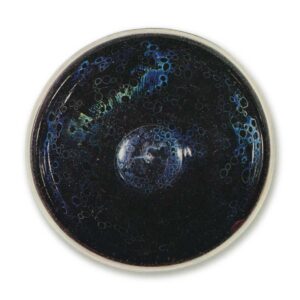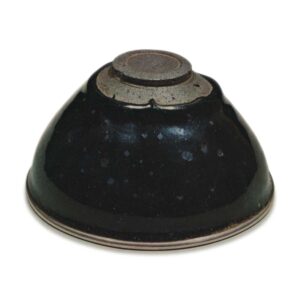

major landmarks
National Treasure
Collection: Fujita Museum of Art
Height: 6.4-6.8 cm
Mouth diameter: 12.3 cm
Outer diameter of base: 3.8 cm
Height of the same: 0.4 cm
The clay is iron-colored firm clay, like other Jian ware Tenmoku tea bowls, and the skin is smooth, probably due to the fast potter’s wheel, and even shows a dull luster from years of hand shaving. The rest of the surface is covered with glaze, and the mouth rim is covered with a silver rim.
The glaze, which is the life of this bowl, can be described as a glassy dark black glaze.
However, it is not uniformly so, and there are subtle changes in the color depending on whether the glaze is thick or thin. First, let’s look at the inner surface. The area near the mouth rim has a lighter glaze, so the glaze color is slightly tinted black, reflecting the underlying clay color, but everything else is a deep black.
If you look closely at the deep black surface of the glaze, you will notice many small spots scattered on the surface. This is the root of yohen. If we look at the glazed surface from an angle so that the light does not reflect diffusely, we can see many small rings of dull silver-gray color floating on the glazed surface. Inside these rings are black dots. When oblique light is shone on them, the dull-colored rings emit a brilliant luminance, such as a deep blue or dark blue. The mysterious shining yōhen, therefore, is not the sunspot itself, but the ring surrounding the spot.
However, if we go one step further, we find that the blue light emitted is most prominent in this circle, but it also extends to the surrounding area. As mentioned in the introduction, it is the extremely thin film on the glazed surface that causes the phenomenon of yohen.
When oblique light is shone on this film, complex diffuse reflections occur, resulting in yohen, and these reflections are particularly strong in the rings. On the contrary, the sunspot within the ring, for some reason or other, hardly causes diffuse reflection of the film. Therefore, the blue light surrounding the sunspot shines on the glaze like the corona of a solar eclipse.
If you look at a bird’s-eye view of the prospect, you will see a point on the upper left where the blue light is radiating from a cup of rabbit. This is because the sunspot did not stop as a point but flowed downwards in a streak, which caused the surrounding blue light to be cut off by the rabbit cup. These black spots or black streaks can be considered as a kind of oil droplets and the rabbit cup cups they flowed on. They interfere with the diffuse reflection of the coating and produce rings and Susan Susan’s blue light. In this tea bowl, the iridescence is so strong that the iridescence is extremely bluish and sometimes gives a colorful impression as if it is a rabbit’s spotted glaze. This type of glaze was obtained only under very favorable conditions, and it is not surprising that it is one of the best or second best among the world’s five remaining Yohantenmoku pieces. The outer side of the bowl seems to have been in somewhat worse condition than the inner side, with less iridescence on the coating and duller yohen, but since this is the only example of yohen on the outer side, it must be highly prized as a world treasure.
This tea bowl, which has been renowned since ancient times as a great masterpiece, was given to Mitsukuni Mito by Ieyasu Tokugawa, and passed down through the generations in the Mito Tokugawa family, but was sold to the Fujita family in the Taisho period (1912-1926) when the family sold out. The original tenmokudai was moved to the Fujita family when the family sold out in the Taisho period.



